Tong W. Wind Power Generation and Wind Turbine Design
Подождите немного. Документ загружается.

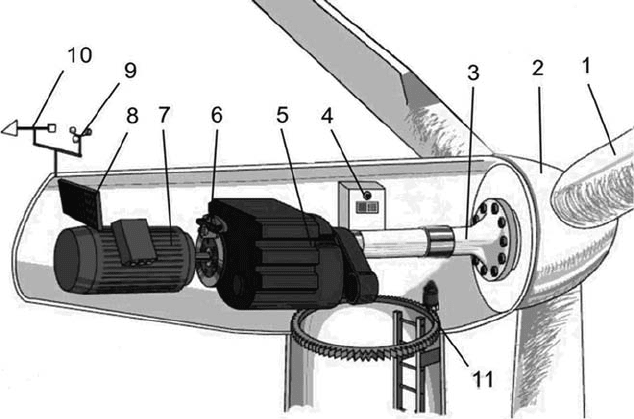
Wind Turbine Cooling Technologies 615
2.1 Gearbox
The gearbox is the bridge connecting the impeller and the generator. Since the
rotational speed of an impeller is between 20 and 30 rpm, and the rated speed of a
generating rotor is from 1500 to 3000 rpm or even higher, therefore a gearbox has
to be installed between the impeller and the generator to accelerate the low-speed
shaft. The running gearbox causes some power loss, most of which transfers into
heat and is absorbed by the lubricating oil and, thus, causes temperature rising in
the gearbox. If this temperature becomes too high, it will deteriorate the perfor-
mance of lubricating oil, causing lower viscosity and shorter drain period. More-
over, it also increases the possibility of damage to the lubricating fi lm under load
pressure, which leads to impairment of the gear meshing or the bearing surface
and, eventually, the equipment accident. Therefore, restriction of temperature rise
in the gearbox is a key prerequisite for its endurable and reliable operation [5].
On the other hand, in winter, when the ambient temperature is below 0°C, heating
measure for the lubricating oil in gearbox should also be taken into consideration
in order to avoid lubricating oil from failing to splash onto the bearing surface due
to high viscosity in low temperature, and, therefore, prevent impairment of the
bearing from short of lubrication. Normally, every large-scale wind turbine gear-
box contains a compelling cooling system and a heater for lubricating oil. How-
ever, in some regions where the temperature seldom drops below 0°C, such as the
coastal areas in Guangdong Province, China, heaters can be an exemption [6].
Figure 2: Sketch of a wind generating set [4]: 1, impeller blades; 2, hub; 3, main
shaft; 4, controller; 5, gearbox; 6, mechanical brake; 7, generator;
8, cooling system; 9, anemoscope; 10, wind vane; 11, yawing motor and
yawing bearing.
616 Wind Power Generation and Wind Turbine Design
2.2 Generator
The generator rotor is connected to the high-speed shaft of the gearbox. It
drives the generator to rotate at a high speed and to cut the magnetic lines of
force, by which electric energy is obtained. During the operation of a wind
turbine, the generator will produce a huge amount of heat mainly in its wind-
ings and various internal wastes of iron core, primarily comprised of iron loss,
copper loss, excitation loss and mechanical loss [7]. Besides, the temperature
rise of the generator also has a correlation with power, operational condition,
and duration of runs [8]. Moreover, there is a tendency of the unit-capacity
enlargement of wind turbine which can be implemented by magnifying wind-
ing factor or magnetic fi eld intensity. Since adding electromagnetic load is
unsatisfactory with the restriction of magnetic saturation, at present, a popu-
lar method for enlarging the unit capacity is to increase inductance coil load.
However, by applying this method, copper loss of bar will rise, which results in
high coil temperature, acceleration of insulation aging and, eventually, damage
of the machine. Because of this, a proper cooling method should be applied to
control the internal temperature of various components of the generator within
a permissible range. Hence, it can be concluded that the enlargement of the
unit capacity of wind turbine mainly depends on the improvement of the cooling
technology [9, 10].
2.3 Control system
As the wind speed and direction are changing all the time in the operation of
wind turbine, auxiliary apparatus should be installed to adjust the operating sta-
tus promptly to ensure the secure and stable operation of the wind turbine. The
common system auxiliary apparatuses include: anemoscope, wind vane, yawing
system, mechanical brake and thermometer. The anemoscope and the wind vane
are used to detect immediate wind status; and the thermal sensor is responsible
for monitoring the temperature changes in the generator and gearbox. When the
operating status changes, the anemoscope, the wind vane and the thermal sensor
will feed back the detected signal to the control system in the nacelle, then the
input signal is diagnosed and processed by the control system and fi nally output
to the yawing system and the mechanical brake, which changes the operating
status of the wind turbine. Meanwhile, the control system has functions of dis-
playing and recording parameters such as instantaneous mean wind speed, mean
wind direction and mean power and other operating parameters. In addition,
frequency converter is equipped in the control system, which aims at converting
the unstable frequency of wind turbine signal to suffi ce to the demands of paral-
lel operation. Therefore, the control system is also called control converter. In
the operation, as a core component for the failure-free operation of wind turbine,
the control system will produce a large amount of heat, which needs to be taken
away timely.
Wind Turbine Cooling Technologies 617
3 Current wind turbine cooling systems
As has been mentioned above, in the operation of wind turbine, the gearbox,
generator and control system will produce a large amount of heat [11]. In order
to ensure the secure and stable operation of wind turbine, effective cooling mea-
sure has to be implemented to these components. Since the early wind turbines
had lower power capacity and correspondingly lower heat production, the natural
air cooling method was suffi cient to meet the cooling requirement. As the power
capacity increases, merely natural air cooling can no longer meet the requirement.
The current wind turbines adopt forced air cooling and liquid cooling prevalently,
among which, the wind generating set with power below 750 kW usually takes
forced air cooling as a main cooling method. As to large- and medium-scale wind
generating set with power beyond 750 kW, a liquid recirculation cooling method
can be implemented to satisfy the cooling requirement [11].
3.1 Forced air cooling system
The forced air cooling system comes up where a znatural air cooling system cannot
meet the cooling demands. When the air temperature in the wind turbine exceeds a
certain prescribed value, to achieve the cooling objective, the control system will
open the fl ap valve connecting internal and external environment of the nacelle
and, meanwhile, fans installed in the wind turbine are switched on, which produce
forced air blast to the components inside the nacelle. As the performance of air
cooling ventilation system has a decisive infl uence on the cooling effect and operating
performance of the wind turbine, the ventilation system should be well designed [9].
Thus, the design of the ventilation system is vital to an air cooling system project.
In the implementation of a forced air cooling system, different combinations are
chosen according to the amount of system heat production and heat dissipation of
various components. For a wind turbine with a power below 300 kW, since the
heat dissipation of the generator and control the converter is relatively low, their
heat is removed mainly by the cooling fans installed on the high-speed shaft, and
the gearbox is cooled using a method of splash lubrication due to the rotation of
the gear, where the heat of formation (or producing heat) is delivered through the
gearbox and additional fi ns to the nacelle, and fi nally taken away by the fans. The
cooling performance is mainly subject to the ventilating condition in nacelle [5].
By comparison, a wind turbine with power capacity beyond 300 kW possesses a
comparatively larger heat production and, therefore, it is not suffi cient for the
gearbox to control the temperature rise only by the cooling fan installed on the
high-speed shaft and the radiated rib on the box. The method of lubricating oil
circulation can realize effective cooling. The basic operating procedure is described
as follows: the gearbox is confi gured with an oil circulation supply system, driven
by a pump and an external heat exchanger. The oil temperature can be adjusted
under the permissible maximum value by regulating the oil delivery rate and the
wind speed fl owing through the heat exchanger according to the temperature rise
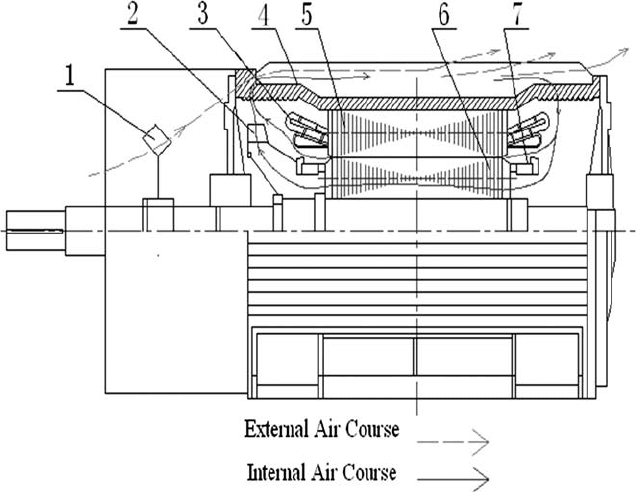
618 Wind Power Generation and Wind Turbine Design
status of the lubricating oil. This circulating lubrication cooling method is mature
and secure in performance, while, on the other hand, it introduces a set of attach-
ments which costs about 10% of the gearbox’s manufacturing cost [5]. Consider-
ing the cooling for the increasing heat production in the generator and the converter,
it can be implemented by enlarging the internal ventilation space and internal air
passage of coil. Usually, the generator has both internal and external fans. And the
radiating rib with an internal air passage is welded on the outer edge of the stator
frame. Thereby, the internal circulating cooling air follows a circuit fl owing
through the terminal stator winding, iron core and the internal air passage of the
radiating rib, while the external cooling air fl ows directly through the surface of
the radiating ribs, as shown in Fig. 3 [12]. Theoretically, the more input air and the
higher speed of the fan, the better the cooling effect. However, this will lead to
increase fl ow resistance and power consumption, all of which result in a lower
generator effi ciency. Therefore the working condition of the generator fan should
be designed rationally [13].
Comparing with other cooling method, the forced air cooling system has several
advantages, such as simple structure, easy management and maintenance, and low
initial and running cost. However, since the cooling air is from external environ-
ment, the cooling performance might become low because of the environment
Figure 3: Forced air cooling method for generator: 1, external fan; 2, internal fan;
3, stator winding; 4, stator frame; 5, stator iron core; 6, rotor iron core;
7, rotor winding.
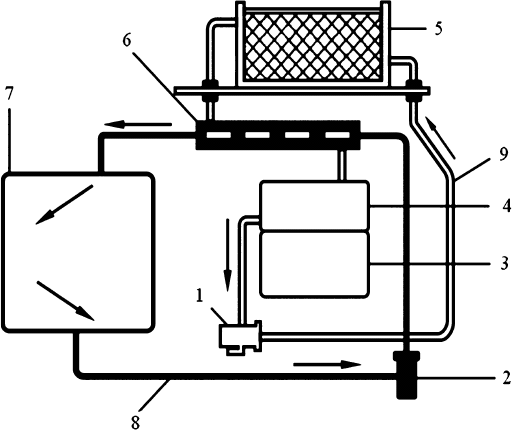
Wind Turbine Cooling Technologies 619
changes. Furthermore, during the ventilation of the nacelle, the severe corrosion
on the set possibly caused by blown sand and rain goes against the long-term
secure operation of the set. As the power capacity of the wind generating set keeps
increasing, merely adopting forced air cooling method could not meet the cooling
demands. Hence, liquid cooling systems are emerging.
3.2 Liquid cooling system
From the thermodynamics knowledge, the thermal equilibrium equation of a wind
turbine cooling system can be described as Q = q
m
C
p
( t
1
– t
2
), where Q is the total
system heat, q
m
is the mass fl ux of the cooling medium, C
p
is the mean specifi c
heat at constant pressure of the cooling medium between temperature t
1
and t
2
.
t
1
and t
2
are the inlet and outlet temperature of the cooling medium. As the liquid
medium’s concentration and specifi c heat capacity are much greater than that of
the gaseous medium, the cooling system adopting liquid medium can obtain much
larger cooling capability as well as a more compact system structure which can
solve the problem of low cooling output and the enormous size of the air cooling
system. The structure of the cooling system is shown in Fig. 4 .
During the operation of a wind turbine, the cooling medium fi rstly fl ows through
the oil cooler, exchanging heat with lubrication oil and taking away the heat pro-
duced by the gearbox. Then it fl ows into the heat exchanger fi xed around the stator
Figure 4: Cooling system adopting liquid cooling method [9]: 1, water pump;
2, oil pump, 3, generator; 4, generator heat exchanger; 5, external
radiator; 6, oil cooler; 7, gearbox; 8, lubricating oil pipeline; 9, cooling
medium pipeline.
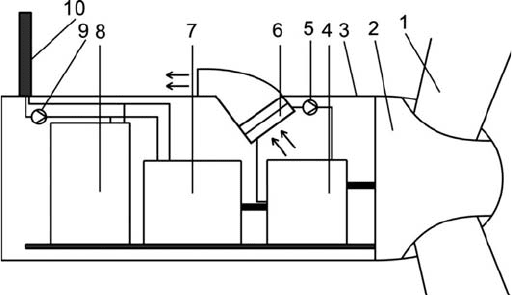
620 Wind Power Generation and Wind Turbine Design
winding, absorbing the heat produced by the generator. Finally, it will be pumped
out and get cooled by an external radiator, by which the fl ow is prepared for the
next cycle of heat exchange. In normal working condition, the cooling water pump
always stays in working mode to deliver the internal heat to the external radiator
through cooling medium. And the lubricating oil pump can be controlled by the
temperature sensor in the gearbox. When the oil temperature exceeds the rated
value, the pump switches on, delivering the oil to the oil cooler outside the gear-
box; while the oil temperature falls below the rated value, the circuit is cut off to
stop the cooling system. Besides, as the control converter in each wind generating
set varies to each other, there will be difference in the amount of heat produced
among these converters. When the heat production is relatively low, the forced air
cooling generated by the fan fi xed in the nacelle is suffi cient for the control con-
verter and other heat producing components; while if the heat production is com-
paratively large, a radiator outside the control converter can be installed to control
its temperature rise through cooling medium taking away the heat in the same way
of gearbox and generator.
With respect to the MW wind turbine with a larger power capacity, the gearbox,
generator and control converter all produce comparatively large amount of heat.
As shown in Fig. 5 , cooling these components mentioned above usually needs two
independent sets of cooling system – one shared by the generator and control con-
verter and the other for the gearbox [14]. In an oil cooling system, the lubricating
oil is pumped up to lubricate the gearbox; the heated oil is then to be delivered to
the oil cooler on top of the central nacelle to be cooled by forced air. The cooled
lubricating oil is then delivered back to the gearbox for use of the next cycle. A
liquid cooling system is a closed-loop system containing an ethylene glycol aque-
ous solution-air heat exchanger, a water pump, valves, and control devices for tem-
perature, pressure and fl ux. The cooling medium in the closed-loop system fl ows
through the generator and the control converter to take away their produced heat.
Figure 5: A cooling system for one MW wind turbine [14]: 1, blade; 2, hub;
3, nacelle; 4, gearbox; 5 and 9, hydraulic pump; 6, oil cooler; 7, generator;
8, converter; 10, heat exchanger.

Wind Turbine Cooling Technologies 621
Then it gets cooled in the external radiator on top of the rear of the nacelle, and
fi nally runs back to the generator and the control converter to begin the next
cooling cycle.
At present, the cooling mediums commonly used in the liquid cooling system
are water and ethylene glycol aqueous solution. Comparing with water, ethylene
glycol aqueous solution has better anti-freeze property. Table 1 shows freezing
points of ethylene glycol aqueous solution in different densities. By adding a cer-
tain amount of stabilizers and preservatives, the minimum working temperature
can extend to –50°C, but keeps its heat transfer performance equivalent to that of
water [19].
Besides, in order to enhance the heat-exchange performance, the external heat
exchanger adopts an effective and compact plate-fi n structure, which is usually
made of the light metal, aluminum. The heat exchanger exposed to the external
environment is prone to be corroded, which will affect the durable, reliable opera-
tion of the heat exchanger. Therefore, necessary anti-corrosion treatments need to
be implemented, like coating the aluminum fl akes with anti-corrosive allyl resin
coverings and employing hydrophilic membranes on its outer surface. Having
been treated with this method, the acid rainproof of the aluminum fi ns and the anti-
salt corrosion property can be 5–6 times as large as those of the ordinary ones.
In the design of the heat exchanger, due to relatively large difference of the cooling
system operating loads in winter and summer, the summer operating mode is adopted
as the design condition, while the heat transfer effi ciency can be controlled through
a bypassing method in winter.
Comparing with the wind turbine adopting the air cooling method, the one
adopting liquid cooling system has a more compact structure. Although it increases
the cost of heat exchanger, cooling medium and corresponding laying of connecting
pipelines, it extremely enhances the cooling performance for the wind generating
Table 1: Freezing points of ethylene glycol aqueous
solution in different densities.
Density (%) Freezing point (°C)
0 0
5 − 2.0
10 − 4.3
20 − 9
30 − 17
40 − 26
50 − 38
60 − 50.1
70 − 48.5
80 − 41.8
85 − 36
90 − 26.8
100 − 13
622 Wind Power Generation and Wind Turbine Design
set, and thus facilitates the generating effi ciency. Meanwhile, the design of the sealed
nacelle prevents the invasion of wind, blown sand and rain, creating a good working
surrounding for the wind turbine, which greatly extends the duration of the devices.
4 D esign and optimization of a cooling system
As has been mentioned above, the increasing power capacity of wind turbines calls
for a matching cooling system. With the widespread use of MW wind turbines, the
liquid cooling system has been prevalently used in current wind turbines. Accord-
ingly, the design and optimization of a liquid cooling system is briefl y introduced
in this section. Since currently very few researches are conducted on the heat dis-
sipating regularity in wind turbine operation and experimental data are scarce,
the following research is based on a steady working condition, where the heat
production of the generating set is under a steady-state condition. According to the
ambient conditions and technical requirements provided by wind turbine compa-
nies, the liquid cooling system is designed and analyzed under the maximum heat
load. On this basis, the commercial software, MATLAB, is used for the purpose
of optimal design, and the interaction and mechanism of action are investigated
among parameters, such as wind speed, fi n combinations, etc. These researches
are somehow valuable to be referred to for the design and optimization of the MW
wind turbine cooling system.
4.1 Design of the liquid cooling system
The cooling system of one certain MW wind turbine is shown in Fig. 5 . This sec-
tion proposes the design of the liquid cooling system for the generator and the
control converter, which is shown as follows [ 14 ]. And as the designs of oil cool-
ing system and liquid cooling system are basically the same, contents on those will
be excluded due to restriction of the article length.
4.1.1 Given conditions
This MW wind turbine is located in the coastal area with a temperature ranging
from − 35 to 40°C. The start-up wind speed is 4 m/s, while the shutdown wind speed
is 25 m/s. The relationship between the generated output P and wind speed V
c,in
is
shown in Fig. 6 . Other initial parameters are shown in Table 2 . The objective is to
design a liquid cooling system to meet the cooling demands of the wind turbine and
to control its structural sizes to be most favorable for the durable operation of the
wind turbine based on the giving ambient conditions and technical requirements
from the wind turbine companies. Focusing on this objective, this section introduces
how to select key components and explain the method of optimal computation to
obtain the size of the ethylene glycol aqueous solution-air-typed heat exchanger.
4.1.2 Selection of the cooling medium
To meet the technical requirement of − 35°C for the minimum ambient temperature
in winter, the ethylene glycol aqueous solution with a concentration of 50% and a
freezing point of − 38°C is picked according to Cao [ 15 ] and Tan [16].
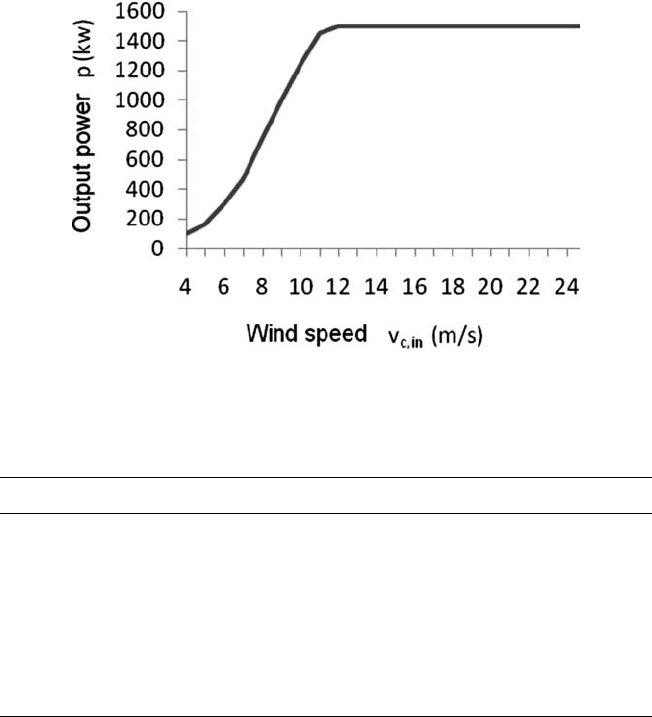
Wind Turbine Cooling Technologies 623
4.1.3 Selection and design of the radiator
Normally, the operating performance of a cooling system mainly depends on the
selection and the design of the heat exchanger. The heat exchanger in a practical
operation should be, more or less, vibration-proof, because the vibration in the
nacelle is driven by wind. In addition, if the wind turbine is located in a coastal
area with comparatively high humidity, the heat exchanger should be corrosion-
proof as well. Considering all the requirements mentioned above, the fi nal choice
for the radiator is an aluminum plate-fi n heat exchanger with not only high heat
transfer effi ciency, but also a compact, light and fi rm structure [ 17 , 18 ]. As shown
in Fig. 7 , where Channel A is air-fl ow passage, and B is the channel for ethylene
glycol aqueous solution. The distribution of the channel is ABABABAB…. The
detailed design of this cross-current plate-fi n heat exchanger can be referred to
Wang [ 17 ] and only necessary introduction is covered in this section due to space
limitation.
Figure 6: Relationship between the generated output of the wind turbine and the
wind speed [ 14 ].
Table 2: Given parameters.
Items Generator Control converter External radiator
Effi ciency, h 97% – –
Heat dissipation (kW) 3% of the output 19 –
Maximum inlet water
temperature (°C)
50 45 –
Flux (l/min) 50 60 –
Pressure loss (MPa) 0.08 0.1 ≤ 0.01 liquid side
External dimensions
(m × m × m)
– – 1.900 × 0.820 × 0.200
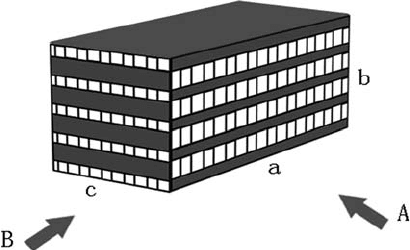
624 Wind Power Generation and Wind Turbine Design
4.1.3.1 Selection of the fi n unit and related dimension calculation
Calculation of the heat transfer area of air side and liquid side. 1.
Assuming that the density, thermal coeffi cient, constant-pressure specifi c heat
capacity and kinetic viscosity of air and ethylene glycol aqueous solution stay
constant in the heat transfer, their values are selected according to the inlet and
outlet mean temperature.
Calculation of heat transfer temperature difference and heat transfer coeffi cient .2.
Fin effi ciency and surface effi ciency of the air side and liquid side .3.
Total heat transfer coeffi cient of the air side and liquid side .4.
Checking and calculating heat exchanger thickness .5.
After obtaining the heat transfer coeffi cient and logarithmic mean temperature
difference of both air side and liquid side, the real transfer area and heat exchanger
thickness can be calculated. If the actual calculated thickness c
real
of heat exchanger
does not equal the given c , the value of c should be reassumed and calculated following
steps (1)–(5) of the fl ow path until the calculated c
real
equals the default c .
4.1.3.2 Calculation to other parameters of the heat exchanger
Pressure loss on the liquid side.1.
In order to meet the technological requirement and the pump selection require-
ment, the resistance of the heat exchanger should be checked in the design
process. When the fl uid is in a pump circulation in the plate-fi n heat exchanger,
the resistance calculation can be divided into three parts, i.e. inlet tube, outlet
tube and central part of the heat exchanger [ 17 ].
Calculation of heat exchanger effi ciency and weight. 2.
4.1.3.3 Selection of the head plate for the plate-fi n heat exchanger
According to Liu et al. [ 19 ] and Zhou et al. [ 20 ], staggered perforated plate header
is selected in order to obtain well-proportioned fl ux distribution and well-controlled
fl uid friction loss.
Figure 7: Core unit of a cross-current plate-fi n heat exchanger [ 17 ]: (A) air-fl ow
passage; (B) ethylene glycol aqueous solution channel; (a) the width of
the core unit; (b) height of the core unit; (c) thickness of the core unit.
